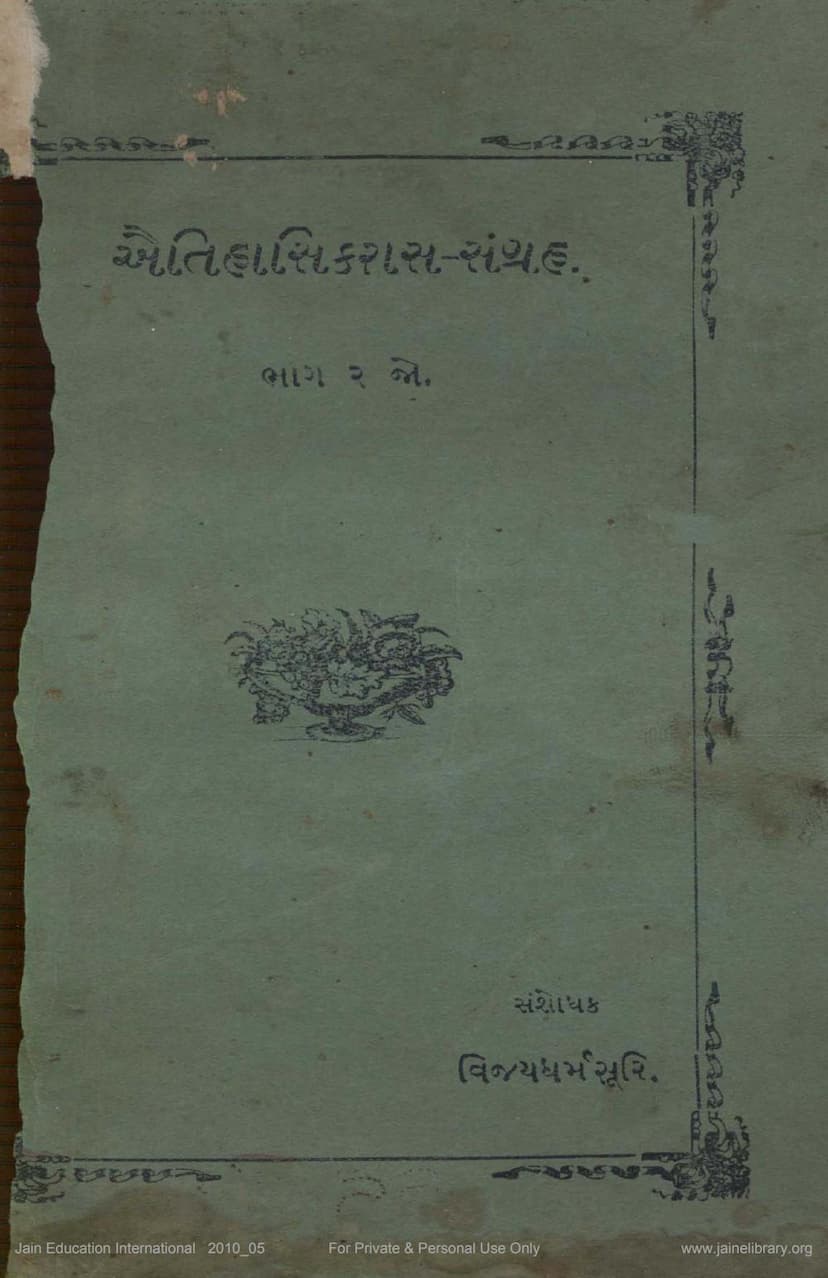Aetihasik Ras Sangraha Part 2
Added to library: September 1, 2025

Summary
Here is a comprehensive summary of the Jain text "Aetihasik Ras Sangraha Part 2" by Vijyadharmsuri, based on the provided pages:
Overall Purpose and Content:
"Aetihasik Ras Sangraha Part 2" is a collection of historical Jain narratives presented in the form of "Ras" (a type of poetic narrative). The book aims to bring to light the significant contributions of various Jain Acharyas and prominent figures to the Jain tradition, highlighting their lives, their spiritual prowess, and their role in propagating Jainism. It emphasizes the historical accuracy and value of these narratives, drawing upon ancient inscriptions and manuscripts.
Key Figures and Narratives:
The second part of this collection focuses on three central figures who are presented as a Guru-disciple lineage:
-
Khim Rishi (Khima Rishi / Khimarshi): The first part of the collection details the life and austerities of Khim Rishi. The narrative highlights his extreme vows and unwavering devotion to Jain principles. It recounts his trials and tribulations, his profound patience (which earned him the name "Khimarshi" - Rishi of patience), and his encounters with supernatural beings and societal challenges. His ability to endure hardships and his unwavering faith are emphasized as pivotal in demonstrating the power of Jain dharma. The text also mentions his rigorous ascetic practices and specific vows.
-
Balibhadra: The second section of the collection narrates the life of Balibhadra, a disciple of Yashobhadra Suri. Balibhadra is portrayed as a learned and powerful individual who used his knowledge and spiritual abilities to benefit the Jain community and uphold the glory of Jainism. The narrative highlights his intellectual prowess and his role in the liberation of the Girnar pilgrimage site from the oppressive rule of King Bengar. It also touches upon his mystical abilities and his sometimes-controversial use of them, leading to his eventual separation from the main monastic order. His story illustrates the impact of spiritual power and knowledge in influencing worldly affairs.
-
Yashobhadra Suri: The third and final narrative focuses on Yashobhadra Suri, a prominent Jain Acharya. The text details his extraordinary life, his profound knowledge, and his miraculous feats. It describes his deep devotion to Jain teachings, his ascetic practices, and his ability to overcome significant challenges, including philosophical debates and opposition from other religious traditions. The narrative emphasizes his role as a spiritual guide and his impact on the spread and preservation of Jainism. His ability to influence Kings and dignitaries, and his own unwavering commitment to spiritual principles even in the face of adversity, are highlighted.
Author and Context:
The book is authored by Acharya Shrivijaydharmsuri, an accomplished Jain scholar and researcher. The publication is a testament to his dedication to uncovering and preserving historical Jain literature. The introduction (Prastavna) emphasizes the importance of such works for historical research and acknowledges the positive reception of the first part of this series. The second edition of this book includes additional historical information, indicating its popularity among history enthusiasts.
Key Themes and Values:
- Spiritual Power and Austerity: The lives of these figures showcase the immense power attained through rigorous asceticism, self-control, and deep spiritual practice.
- Patience and Perseverance: Khim Rishi's story, in particular, emphasizes the virtue of patience in the face of suffering and adversity.
- Intellectual Prowess and Debate: The narratives highlight the importance of knowledge and intellectual debate in defending and propagating Jain philosophy.
- Devotion and Faith: The unwavering faith of these individuals in Jain principles serves as an inspiration.
- Guru-Disciple Relationship: The interconnectedness of these figures through their spiritual lineage underscores the importance of the Guru-disciple tradition.
- Protection of Jainism: The actions of these Acharyas and their disciples were instrumental in safeguarding and promoting Jain principles and pilgrimage sites.
- Historical Preservation: The book itself is a significant contribution to preserving Jain history and making it accessible to a wider audience.
Publication Details and Recognition:
The book is published by Abhaychandra Bhagwandas Gandhi under the Shri Yashovijay Granthamala series. The text mentions positive reviews from prominent publications like "The Chronicle" and "Modern Review," as well as recognition from Dr. Malabari, President of the last Shvetambara Conference, underscoring the book's scholarly merit and broad appeal.
Structure and Appendices:
The book includes a detailed table of contents outlining the chapters, which include:
- Introduction (Prastavana)
- Kavi Laavanyasamay (The Poet)
- Brief Summary (Sankshipt Saar)
- Khim Rishi Ras
- Balibhadra Ras
- Yashobhadra Suri Ras
- Glossary of Difficult Words (Kathin Shabdarth Sangrah)
- Appendices (Parishisht "A" and "B") containing inscriptions and supporting historical documents.
- Errata (Shuddhipatra)
Kavi Laavanyasamay:
A significant portion of the book is dedicated to the biography of Kavi Laavanyasamay, the renowned poet who composed these narratives. It details his family background, birth, initiation into monkhood, and his literary achievements. His proficiency in language and his ability to create impactful poetry are highly praised. His works are considered significant contributions to Gujarati poetic literature.
In essence, "Aetihasik Ras Sangraha Part 2" is a rich compilation of historical Jain literature, offering deep insights into the lives and accomplishments of key figures who played a vital role in the development and propagation of Jainism.